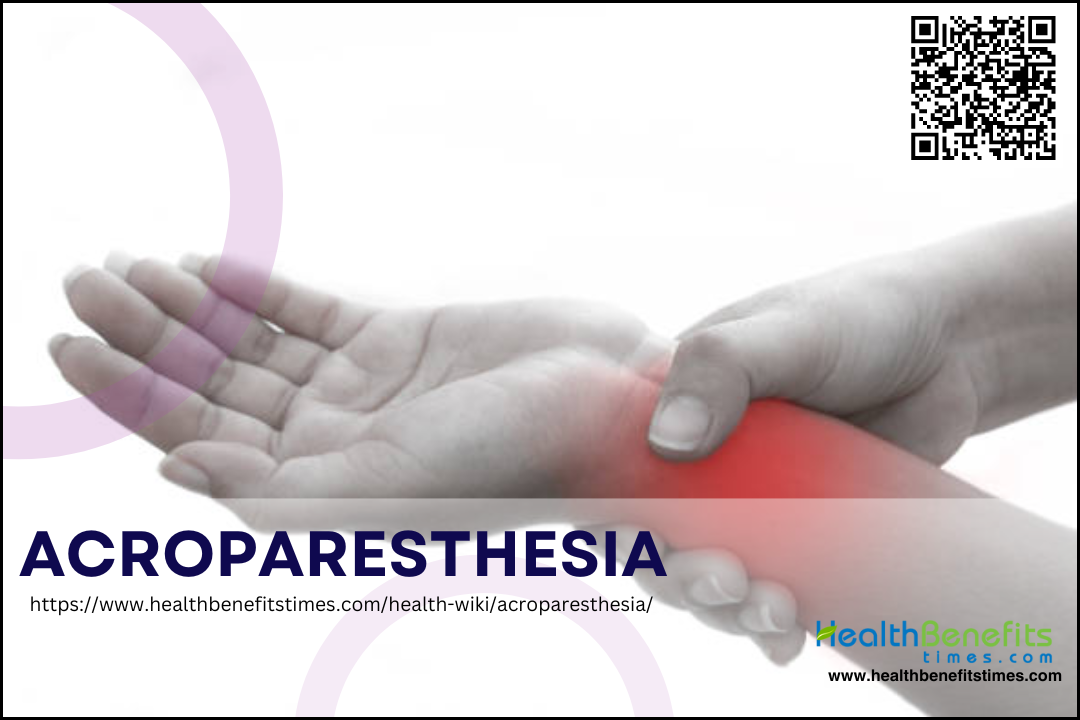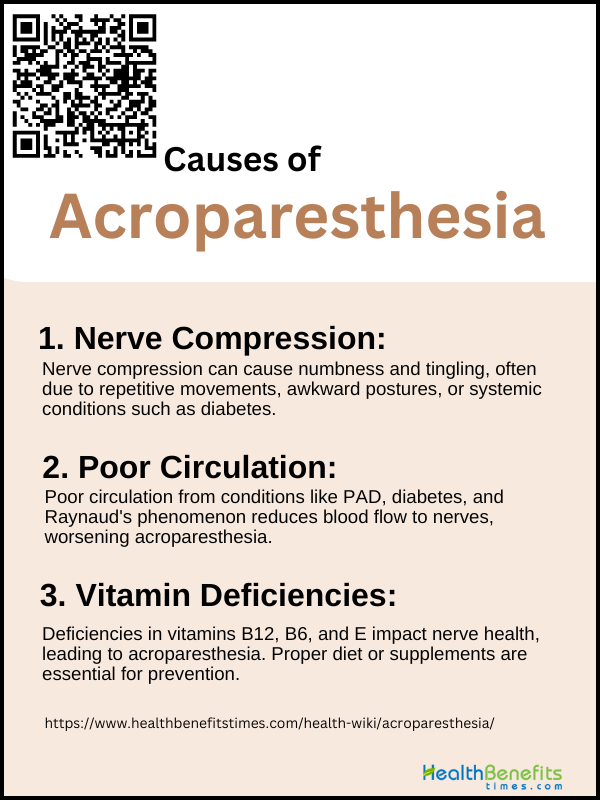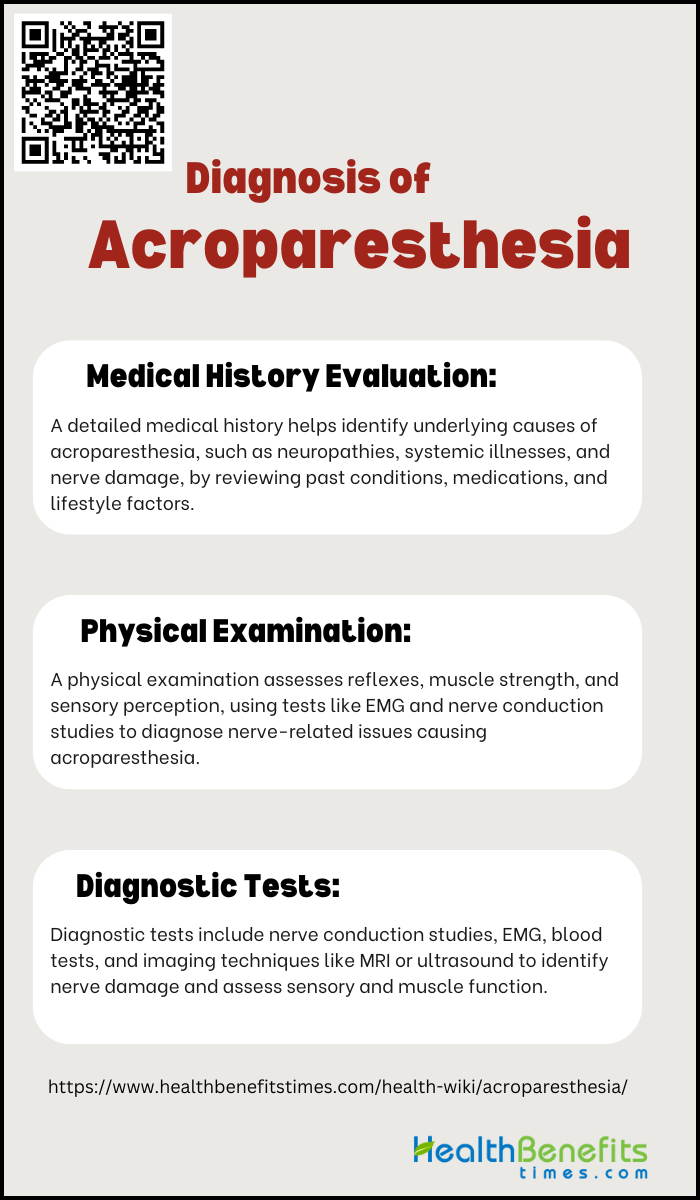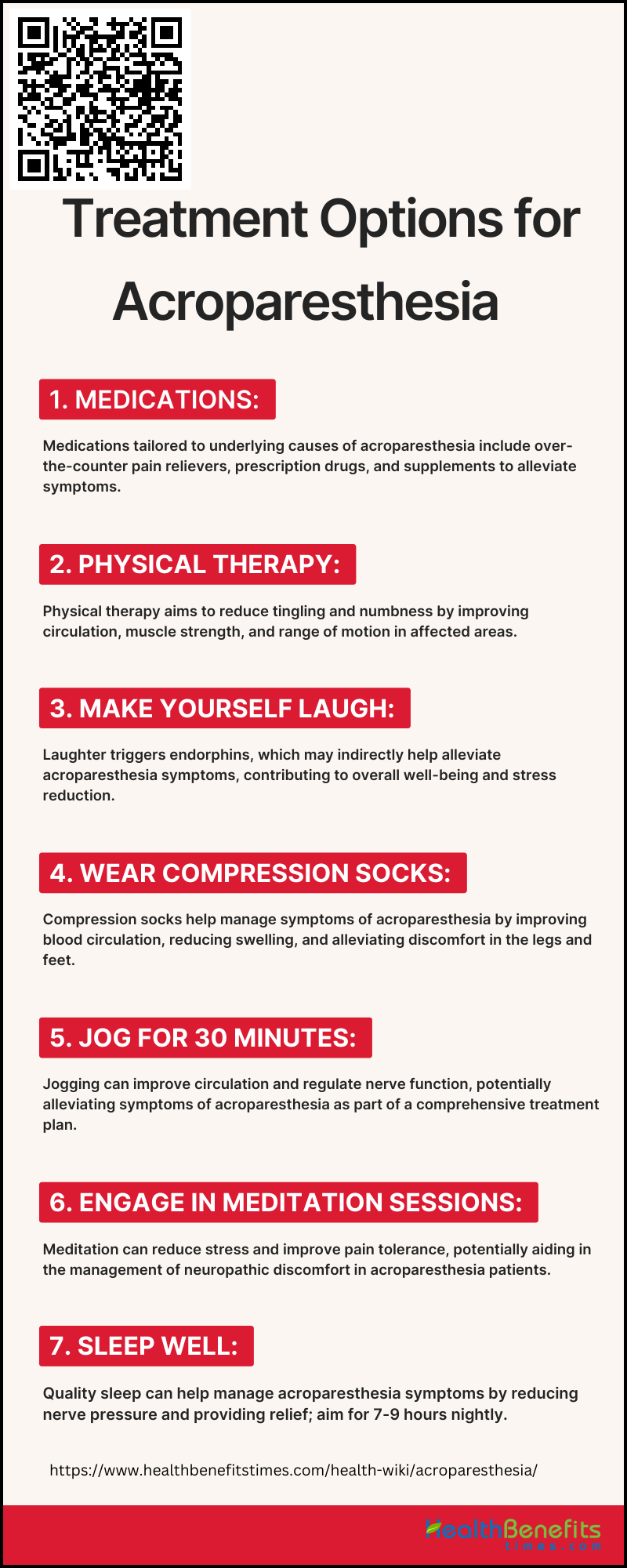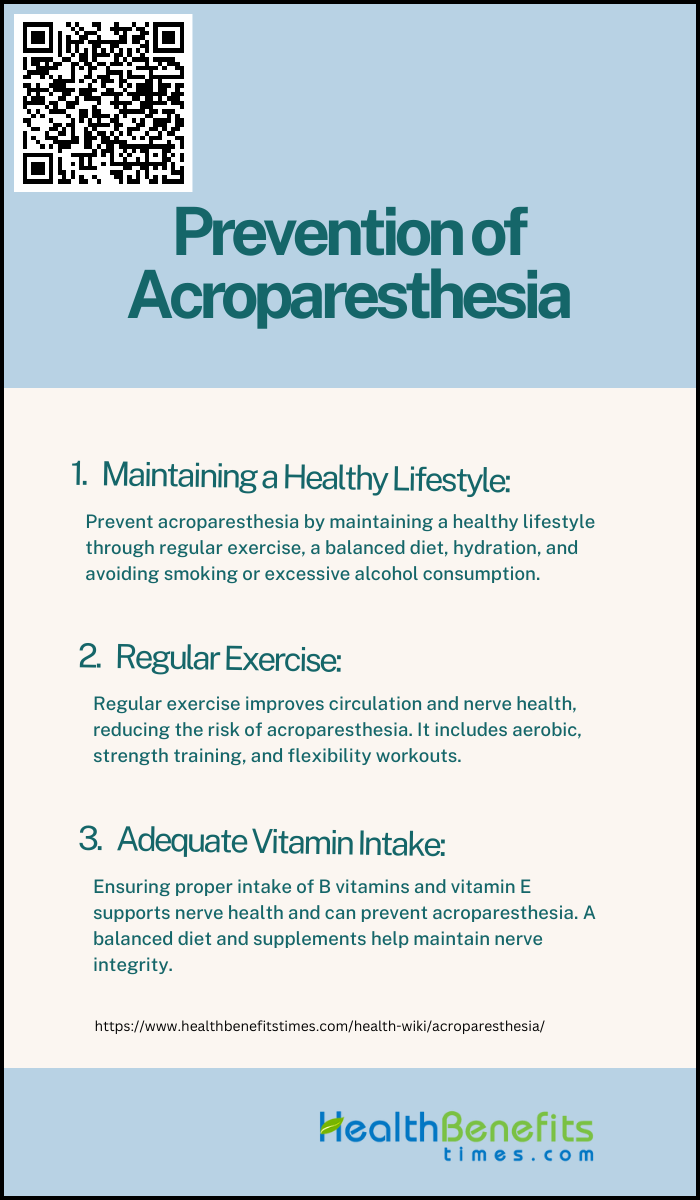According to article, Acroparesthesia is a neurological condition marked by abnormal sensations such as tingling, numbness, or burning, primarily affecting the hands and feet. These symptoms may be more pronounced in the dominant hand and are often episodic, potentially triggered by mechanical compression, repetitive movements, or circulatory issues. Commonly linked to peripheral neuropathy, carpal tunnel syndrome, and systemic diseases like diabetes, the condition can also signal severe disorders such as Guillain-Barré syndrome or vasculitis. Diagnosis can be complex due to the variety of potential causes, which also dictate the management strategy, ranging from lifestyle adjustments to surgical interventions for immediate symptom relief. Ultrasonography can aid in identifying specific causes like nerve entrapment. Effective treatment of acroparesthesia hinges on addressing the root cause, which may involve physical therapy, medication, or managing underlying health conditions to alleviate discomfort and prevent further nerve damage.
Causes of Acroparesthesia?
Acroparesthesia is characterized by sensations of tingling, numbness, or burning in the hands and feet, which can impact daily activities and reduce quality of life. This condition is caused by a variety of factors that affect nerve function, ranging from temporary nerve compression to more severe health issues such as genetic predispositions and lifestyle factors. Healthcare providers take into account these different potential causes and medical conditions when diagnosing and treating acroparesthesia, as the specific cause can vary among individuals. Recognizing the complex origins of acroparesthesia is crucial for determining the most effective treatment for this sensory disturbance.
1. Nerve Compression
Nerve compression plays a significant role in the development of acroparesthesia, which presents with symptoms such as numbness, tingling, and burning sensations in the extremities. This condition can be caused by a variety of factors, including repetitive movements, awkward postures, anatomical abnormalities such as bone spurs or ganglion cysts, and systemic diseases like diabetes. Carpal tunnel syndrome, a common form of acroparesthesia, occurs when the median nerve is compressed at the wrist. Other related conditions, such as cubital tunnel syndrome and tarsal tunnel syndrome, also result from nerve compression. It is crucial to identify and understand the underlying cause of nerve compression for accurate diagnosis and effective management, with the goal of relieving symptoms and preventing further nerve damage.
2. Poor Circulation
Poor circulation, frequently caused by conditions such as peripheral arterial disease (PAD), diabetes, and Raynaud’s phenomenon, results in reduced delivery of oxygen and nutrients to peripheral nerves, worsening symptoms of acroparesthesia. PAD narrows arteries, decreasing blood flow to extremities, while diabetes harms blood vessels and nerves, and Raynaud’s phenomenon involves spasms in small blood vessels that temporarily limit circulation. Lifestyle factors like physical inactivity and smoking can additionally hinder circulation. Recognizing and addressing these root causes are crucial for the successful management and treatment of acroparesthesia.
3. Vitamin Deficiencies
Acroparesthesia, characterized by tingling and numbness in the hands and feet, is often caused by deficiencies in vitamins B12, B6, and E, which are vital for nerve health. Vitamin B12 is essential for myelin production, and its deficiency can result in peripheral neuropathy, while vitamin B6 is crucial for neurotransmitter synthesis, and its insufficiency can disrupt nerve signal transmission. Vitamin E, an antioxidant, protects nerve cells from damage, and its deficiency can lead to neuropathic pain and sensory axonopathy. Inadequate intake or absorption of these vitamins can lead to neurologic dysfunction, emphasizing the importance of a balanced diet or supplementation to maintain nerve function and prevent acroparesthesia.
Symptoms of Acroparesthesia
Acroparesthesia, commonly experienced as tingling or numbness in the extremities, can be a perplexing condition for health enthusiasts. As an indicator of various underlying health issues, recognizing its symptoms is vital for maintaining an organic, wholesome lifestyle. Here’s what to look out for:
1. Tingling Sensation
According to article, Tingling sensation akin to “pins and needles” in the extremities, particularly the hands, feet, fingers, and toes, which can vary from mild and intermittent to persistent and severe enough to disrupt daily activities. Accompanying symptoms may include numbness, prickling, or a burning sensation, which can significantly affect quality of life. This condition is more common in women but also affects men and can indicate various underlying health issues, such as rheumatic diseases like arthritis, polyneuropathy often associated with diabetes, or more serious conditions like Guillain-Barré syndrome or vasculitis. Prompt investigation into the cause of acroparesthesia is essential for effective and timely treatment.
2. Numbness
According to article, Acroparesthesia is characterized by numbness in the extremities, often accompanied by a tingling sensation that results in a reduced ability to sense touch, temperature, or pain, particularly in the hands, feet, fingers, and toes. The degree of numbness can vary from complete loss to sporadic areas, increasing the risk of injury due to decreased sensation. This numbness not only suggests potential underlying conditions such as polyneuropathy, commonly linked to diabetes, vitamin B12 deficiency, monoclonal gammopathy, Fabry’s disease, or mononeuropathies like carpal tunnel syndrome, but also can lead to difficulties with fine motor skills and manipulating small objects. The presence of these symptoms, including finger stiffness and temporary clumsiness, especially upon waking, requires medical evaluation to effectively diagnose and manage any contributing neuropathies or circulatory disorders.
3. Burning Sensation
According to article, a burning sensation in the extremities, particularly the hands and feet, can vary from mild warmth to intense burning pain. This discomfort is often accompanied by tingling, numbness, or a pins-and-needles sensation and may worsen with stress, fatigue, cold temperatures, or lack of movement. These symptoms, which can interfere with sleep and daily activities, are commonly linked to nerve compression or damage and may suggest underlying conditions such as diabetes, Fabry disease, carpal tunnel syndrome, or other peripheral nerve disorders. While the disorder primarily affects women, it can also occur in men. Movement can alleviate the nocturnal symptoms of the disorder. Accurate diagnosis and management are crucial, and individuals experiencing these symptoms should seek medical evaluation to identify the cause and receive appropriate treatment.
4. Cold Sensitivity
According to article, Acroparesthesia, characterized by tingling, numbness, and occasionally a burning sensation in the extremities, can be significantly exacerbated by sensitivity to cold. This increased sensitivity to cold can result in heightened discomfort, a persistent sensation of coldness in the hands and feet, and even changes in skin color from red to blue, accompanied by swelling or tightness. These symptoms can impede daily activities and work, as demonstrated by the Cold Intolerance Symptom Severity (CISS) questionnaire, where a lower sense of coherence is linked to more severe cold sensitivity, particularly in patients with traumatic hand injuries. The severity of these symptoms can vary from mild to severe and may necessitate medical evaluation for effective management, especially as they can impact dexterity and the ability to perform routine tasks.
How to Diagnosis Acroparesthesia
Acroparesthesia, the tingling or numbing sensation in the hands and feet, can be a bewildering experience. Knowing how to recognize its signs is crucial for those attentive to their health. Here’s a straightforward guide to understanding and identifying this condition.
1. Medical History Evaluation
The diagnosis of acroparesthesia, which is closely related to idiopathic carpal tunnel syndrome (CTS), has evolved over time, with its symptoms of nocturnal paresthesias, numbness, and hand weakness initially leading to various hypotheses before the association with median nerve compression was understood. Clinicians now conduct a thorough assessment of the patient’s medical history, symptoms, and any factors that may exacerbate or alleviate the condition, considering past medical conditions, medications, family history, and occupational and lifestyle factors. According to article, this comprehensive review helps to identify potential underlying causes such as neuropathies, vascular disorders, systemic illnesses, or nerve damage, and is essential for differentiating acroparesthesia from other neurological conditions with similar presentations. Further testing informed by this evaluation confirms the diagnosis and informs the development of an effective treatment plan, taking into account the patient’s overall health status and any potential contributing factors such as metabolic disorders, nutritional deficiencies, or autoimmune diseases.
2. Physical Examination
According to article, a physical examination is a crucial tool for healthcare professionals to diagnose a variety of conditions, including musculoskeletal issues like sacroiliac joint pain and shoulder pathologies, as well as nerve-related disorders such as carpal tunnel syndrome, which can result in acroparesthesia. The examination involves evaluating reflexes, muscle strength, sensory perception, and the function of peripheral nerves using tests like electromyography (EMG) and nerve conduction studies (NCS). Provocative maneuvers, such as Phalen’s or Tinel’s test, are utilized to provoke symptoms and identify nerve compression. Additionally, the physician examines the hands and feet for changes in skin color, temperature, or texture, and applies pressure to assess the extent of paresthesia. These findings, in conjunction with the patient’s medical history, allow for an accurate diagnosis and guide subsequent treatment plans.
3. Diagnostic Tests
To diagnose acroparesthesia, healthcare providers employ a combination of diagnostic tests, beginning with a physical examination to assess sensory function and nerve responses. Nerve conduction studies are commonly used to measure the speed and strength of electrical signals in peripheral nerves, while electromyography (EMG) records muscle electrical activity, helping to identify muscle weakness or nerve damage. Blood tests may reveal metabolic or autoimmune disorders, and advanced imaging techniques such as MRI or ultrasound can visualize nerve compression or damage. This comprehensive diagnostic approach, which has evolved since the late 1940s when median nerve compression in the carpal tunnel was identified as a cause for related conditions, allows for an accurate diagnosis and the development of a personalized treatment plan for acroparesthesia.
Treatment Options for Acroparesthesia
The treatment options for acroparesthesia include a range of interventions designed to alleviate tingling and numbness in the extremities. These options include lifestyle changes, physical therapy, medication, and surgery. Patients can select from conservative treatments to more aggressive approaches based on the severity of their symptoms and personal preferences. By working with healthcare professionals, individuals can create a customized treatment plan to effectively manage symptoms and improve their quality of life, ensuring that the chosen strategies address their specific needs.
1. Medications
Acroparesthesia, characterized by tingling, numbness, and pain in the extremities, is treated with a variety of medications tailored to the underlying cause and specific pain location. Commonly used medications include over-the-counter pain relievers such as acetaminophen and ibuprofen, as well as prescription drugs like narcotic analgesics, NSAIDs, anticonvulsants, and tricyclic antidepressants. Vitamin supplements like B12 may be prescribed for nutritional deficiencies, while anti-inflammatory drugs or corticosteroids are recommended for nerve compression issues such as carpal tunnel syndrome. Anticonvulsants and antidepressants are often suggested for chronic nerve pain. Specific treatments like insulin for diabetes or hormone replacement for hypothyroidism target the root causes of the condition. It is important to combine medications with other treatments like physical therapy and lifestyle changes for optimal relief. Healthcare providers should also consider patient compliance and cost in order to improve the quality of life for individuals with acroparesthesia.
2. Physical Therapy
Physical therapy is a crucial non-invasive treatment for acroparesthesia, with the goal of reducing tingling and numbness in the extremities by enhancing circulation, muscle strength, and range of motion. Individualized treatment plans may consist of aerobic, strength, flexibility, and balance exercises, as well as modalities like massage, heat and cold therapy, and electrical stimulation techniques such as TENS and Iontophoresis to alleviate pain and promote muscle contraction. Education on ergonomic principles and the utilization of assistive devices like splints or braces are also included in the therapy to prevent symptom worsening and provide support to affected limbs. Regular physical therapy sessions and adherence to home exercises are essential for gradual symptom improvement and long-term symptom management. It is important for individuals to seek guidance from healthcare professionals to determine the suitability of physical therapy for their specific condition.
3. Make Yourself Laugh
Incorporating laughter into daily life, though not a standard treatment, may offer complementary therapeutic benefits for individuals with acroparesthesia. Laughter triggers the release of endorphins, which are natural painkillers that can reduce stress, improve mood, and enhance the immune system. While it does not directly treat acroparesthesia, activities that induce laughter, such as watching comedies, engaging in social activities, or practicing laughter yoga, could contribute to an overall sense of well-being and indirectly aid in symptom management. It is important, however, to adhere to medical treatments prescribed by healthcare professionals and view laughter as an adjunct to conventional therapies, not a replacement. Proper diagnosis and treatment of acroparesthesia by a healthcare professional remain crucial.
4. Wear Compression Socks
Compression socks are a non-invasive treatment option for acroparesthesia that apply gentle pressure to the legs and feet, enhancing blood circulation, reducing swelling, and alleviating discomfort. Although they do not address the root causes of acroparesthesia, such as nerve compression or circulatory issues, they can be a valuable part of a multifaceted treatment strategy, which may include lifestyle adjustments, medications, and physical therapy tailored to the individual’s diagnosis and symptom severity. These socks not only help in managing symptoms by reducing pressure on the nerves but also support the muscles and ligaments, minimizing injury risks and promoting foot health. To ensure effectiveness and safety, it is crucial to consult a healthcare provider for the proper compression level and sock selection.
5. Jog for 30 Minutes
Jogging for 30 minutes is being considered as a beneficial treatment for acroparesthesia, a condition characterized by tingling, numbness, and sometimes burning sensations in the hands and feet. As part of a comprehensive treatment plan, which may involve medical interventions, dietary modifications, and lifestyle changes, jogging can help enhance blood circulation, reduce stress, and regulate nerve function, potentially alleviating the severity of symptoms. Maintaining a healthy weight through regular jogging may also reduce pressure on nerves, decreasing the likelihood of complications. It is crucial for individuals with acroparesthesia to consult healthcare professionals to develop a personalized and safe treatment plan, ensuring that jogging is suitable for their specific needs and to receive guidance on the proper execution and duration of the exercise.
6. Engage in Meditation Sessions
Meditation has been recognized as a beneficial complementary treatment for acroparesthesia, a condition characterized by sensations of numbness and tingling. Studies have demonstrated that incorporating meditation into conventional treatment protocols can result in significant improvements in various health conditions, such as stroke recovery, chronic low back pain, and atrial fibrillation, by reducing symptoms such as depression, pain, and fatigue. Regular meditation promotes relaxation, enhances blood circulation, and fosters a mind-body connection that may reduce stress levels and improve pain tolerance, aiding in the management of neuropathic discomfort in acroparesthesia patients. Different forms of meditation, including mindfulness and yoga, can be customized to individual preferences and practiced at home or in group settings, with resources such as apps and online classes available for guidance. While not a cure, meditation serves as a holistic complement to traditional treatments, potentially enhancing quality of life and warranting further research to fully comprehend its role in treating acroparesthesia. It is recommended to consult a healthcare professional before incorporating meditation into a treatment regimen.
7. Sleep Well
A comfortable sleep environment, consistent sleep schedule, and relaxing bedtime routine can help alleviate symptoms by reducing nerve pressure during sleep. For individuals with severe symptoms, additional medical treatments such as vitamin supplementation, pain medications, or surgery may be required. Sleep disturbances such as excessive daytime sleepiness and sleep apnea, commonly seen in patients with Fabry disease, do not have a direct connection to organ damage, but it is crucial to address them in the management of acroparesthesia. Continuous positive airway pressure (CPAP) therapy for sleep apnea can also help alleviate symptoms. It is important to aim for 7-9 hours of quality sleep and avoid stimulants before bedtime. Consulting with healthcare professionals is necessary to develop a personalized treatment plan that effectively incorporates these strategies.
How to Prevent Acroparesthesia
Acroparesthesia can be an unsettling experience, often characterized by tingling and numbness in the hands and feet. For health enthusiasts who value an organic lifestyle, incorporating simple, mindful practices into your daily routine can help in preventing this condition.
1. Maintaining a Healthy Lifestyle
The prevention of acroparesthesia, characterized by sensations such as tingling and numbness in the limbs, is closely linked to maintaining a healthy lifestyle. Engaging in regular exercise to improve circulation and nerve function, consuming a balanced diet rich in vitamins B12 and D, magnesium, and antioxidants, and staying adequately hydrated are crucial steps. These practices promote nerve health and can reduce the risk of neuropathy. It is also important to maintain a healthy weight, avoid repetitive strain on the limbs, and refrain from smoking or excessive alcohol consumption, as these can negatively impact circulation and nerve health. Managing conditions like diabetes or hypothyroidism with appropriate medication and lifestyle changes further decreases the chances of developing acroparesthesia. By incorporating these healthy habits into daily routines, individuals can actively protect themselves against this condition and improve their overall well-being.
2. Regular Exercise
Regular physical activity is crucial for maintaining health and can play a significant role in preventing conditions such as acroparesthesia, characterized by tingling and numbness in the hands and feet. Aerobic exercises such as jogging, swimming, or cycling, as well as strength training and flexibility workouts, improve blood circulation and cardiovascular health, essential for delivering oxygen and nutrients to nerve cells and preventing nerve damage. These exercises also reduce peripheral cerebrovascular tone in young women, aiding in the early prevention of cerebrovascular diseases. Additionally, combining exercise with antioxidant agents like grape seed extract can prevent oxidative stress in the heart, reducing issues such as myocardial ischemia. While regular exercise is beneficial for nerve health by reducing inflammation and helping control blood sugar levels, it is not a guaranteed cure for acroparesthesia. Individuals with persistent symptoms should seek medical advice for proper diagnosis and treatment.
3. Adequate Vitamin Intake
Vitamin deficiencies, particularly of B vitamins like B12, B6, B1, and E, as well as folic acid, can lead to neurological issues and peripheral neuropathies such as acroparesthesia, characterized by numbness or tingling in the extremities. Adequate intake of these vitamins is crucial for maintaining nerve health and preventing nerve damage. Research has shown that vitamin E supplementation can stabilize and improve neurological symptoms, such as ataxia, and reduce the risk of coronary heart disease, while a balanced diet or medically-guided supplementation can prevent conditions like acroparesthesia. Multivitamins containing folic acid and zinc also help reduce the risks of low birthweight, premature births, and cardiovascular defects. It’s important to consult a healthcare provider before supplementing, as excessive intake can be toxic. Overall, a diet rich in leafy greens, whole grains, lean meats, and dairy, possibly supplemented with a multivitamin, supports nerve integrity and overall health.


